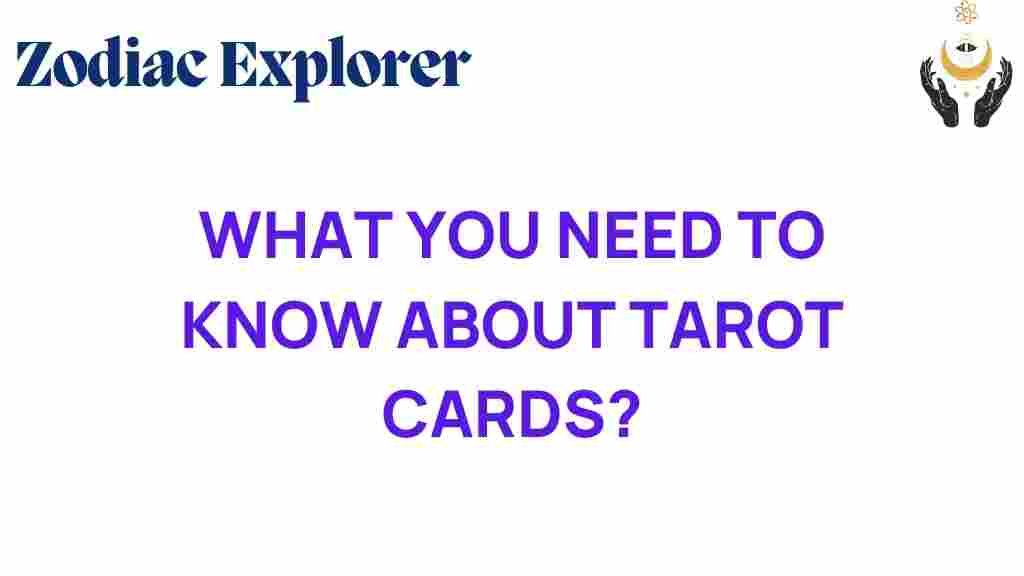Unlocking the Secrets: What You Need to Know About Tarot Cards
Tarot cards have fascinated individuals for centuries, serving as a powerful tool for divination, guidance, and introspection. Whether you’re a novice curious about this mystical practice or someone looking to deepen your understanding, this article will explore the secrets behind tarot cards, their symbolism, and how to effectively use them for fortune-telling and personal insight.
Understanding Tarot Cards
At their core, tarot cards are a deck of 78 cards, each with unique imagery, symbolism, and meanings. They are divided into two main sections: the Major Arcana and the Minor Arcana.
- Major Arcana: Comprising 22 cards, the Major Arcana represents significant life events and spiritual lessons. Each card, such as The Fool or The World, embodies powerful archetypes and themes.
- Minor Arcana: Consisting of 56 cards, the Minor Arcana is divided into four suits: Cups, Pentacles, Swords, and Wands. These cards reflect everyday events and challenges, providing insights into daily life.
The Role of Symbolism in Tarot
Symbolism is a crucial element of tarot cards. Each card is rich in imagery that conveys deeper meanings. Understanding these symbols can enhance your reading and intuitive connection. Here are some key symbols you might encounter:
- Cups: Often associated with emotions, relationships, and intuition.
- Pentacles: Representing material aspects, such as finances, career, and physical health.
- Swords: Symbolizing thoughts, decisions, and conflicts.
- Wands: Reflecting creativity, action, and inspiration.
Developing Intuition for Tarot Reading
Intuition plays a vital role in tarot reading. While the meanings of the cards provide a framework, your intuitive insights can bring a unique perspective to the reading. Here are some tips to enhance your intuition:
- Practice Regularly: The more you work with tarot, the more attuned you’ll become to the meanings and your intuitive responses.
- Journal Your Readings: Documenting your readings can help you notice patterns and grow your understanding of the cards.
- Trust Your Gut: When a particular card evokes a strong feeling or thought, allow yourself to explore that intuition, even if it differs from traditional interpretations.
Step-by-Step Process for Reading Tarot Cards
Reading tarot cards can be a rewarding experience. Follow these steps to conduct your own reading:
Step 1: Set Your Intention
Before you begin, take a moment to center yourself and set a clear intention for your reading. This could be a specific question or a general inquiry about your life.
Step 2: Choose a Tarot Spread
Select a tarot spread that suits your intention. Common spreads include:
- One-Card Draw: A simple way to gain quick insight.
- Three-Card Spread: Often used to explore the past, present, and future.
- Celtic Cross: A more complex spread that provides a comprehensive view of your situation.
Step 3: Shuffle the Cards
While shuffling, focus on your question or intention. This process helps to connect your energy with the deck.
Step 4: Draw the Cards
Once you feel ready, draw the cards according to your chosen spread. Lay them out in the specified positions.
Step 5: Interpret the Cards
Begin interpreting the cards one by one. Consider both the traditional meanings and your intuitive impressions. Look for connections between the cards, as they often tell a story together.
Troubleshooting Common Issues in Tarot Reading
Just like any skill, tarot reading can come with its challenges. Here are some common issues and how to overcome them:
- Feeling Stuck: If you’re struggling to interpret a card, take a break and revisit it later. Sometimes, a fresh perspective can provide clarity.
- Inconsistent Readings: If your readings seem inconsistent, consider whether you are emotionally grounded. Stress or distractions can affect your intuition.
- Overthinking: Trust your first impressions. Overanalyzing can cloud your intuition and lead to confusion.
The Mystical History of Tarot Cards
Tarot cards have a rich history steeped in mysticism. Originating in the 15th century, they were initially created as playing cards in Europe. Over time, they evolved into tools for divination and self-discovery. The association of tarot cards with mysticism and the occult flourished in the 18th century, thanks to influential figures like Antoine Court de Gébelin and Éliphas Lévi.
Today, tarot cards are embraced by a diverse audience, from spiritual seekers to psychology enthusiasts, as a means of exploring the psyche and uncovering hidden truths.
Conclusion: Embrace the Journey with Tarot Cards
Tarot cards offer a rich tapestry of symbolism, archetypes, and intuitive guidance. By unlocking the secrets behind these cards, you can harness their power for personal growth and insight. Whether you’re seeking answers, clarity, or a deeper connection to your inner self, tarot cards can serve as a profound tool for exploration.
As you embark on your tarot journey, remember to approach it with an open mind and heart. Each reading is an opportunity to connect with your intuition and gain wisdom from the universe. For additional resources on tarot reading, consider visiting this guide, and for a deeper dive into the history of tarot, check out this informative article.
Happy reading, and may your tarot journey illuminate the path ahead!
This article is in the category Myths and created by ZodiacExplorer Team
